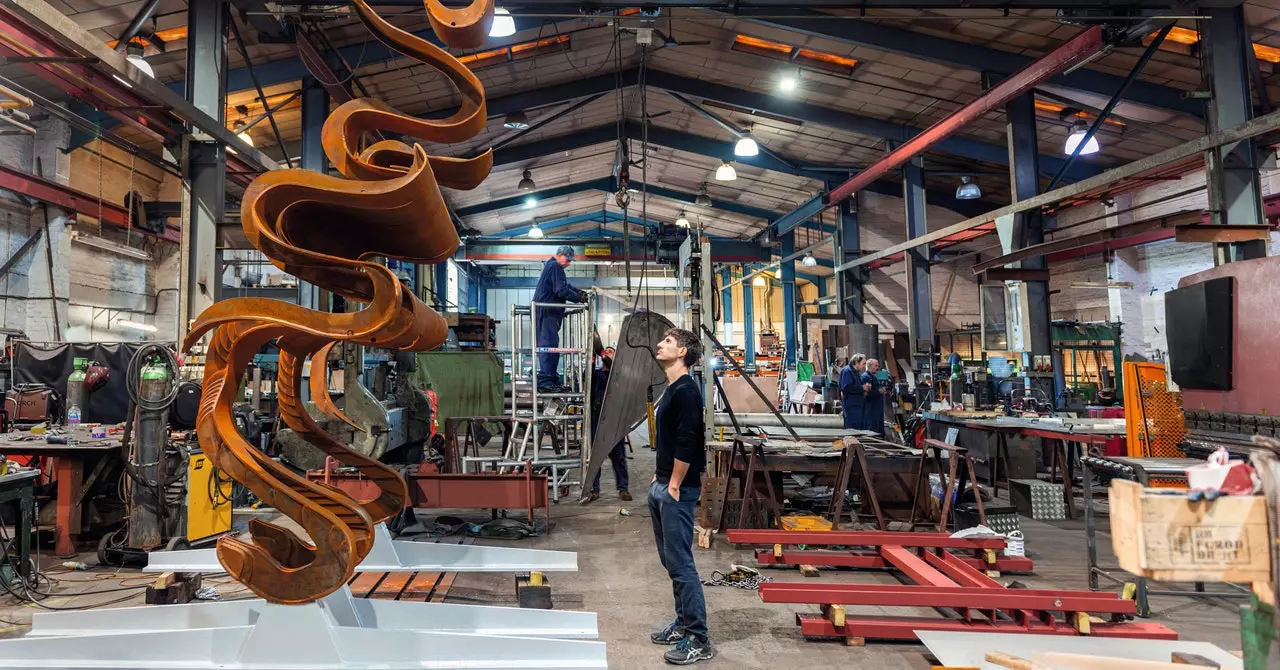London, known for its vibrant art scene, has become home to the works of Nick Hornby, a renowned artist who challenges traditional notions of sculpture. Through his innovative use of digital modeling and 3D printing, Hornby has created a series of sculptures that transcend conventional boundaries. This article explores the unique techniques and concepts employed by Hornby, shedding light on his artistic vision and the profound impact he has made within the art world.
Exploring Metal Silhouettes
In the heart of London, three permanent sculptures by Hornby captivate passersby with their intriguing metal silhouettes. These sculptures, located in St. James and Kensington, offer a captivating experience that evolves depending on the viewer’s perspective. Hornby’s equestrian figure, inspired by Richard I, morphs into an amorphous squiggle as one circles around it. Similarly, his interpretation of Caspar David Friedrich’s Wanderer takes on an abstract form in Kensington. Notably, Hornby’s inventive bust of Nefertiti seamlessly doubles as the Albert Memorial. Through these thought-provoking installations, Hornby skillfully explores themes of power and the role of monuments, leaving viewers questioning their own perceptions.
Blending Craft and Concept
Hornby’s sculptures are not just visually striking; they are also remarkable feats of digital innovation. The artist employs a multidisciplinary approach, combining meticulous craftsmanship with conceptual depth. For instance, the equestrian sculpture began its journey as a digital model scripted in Python, a programming language. It was then deconstructed into individual components, which were laser-cut from metal and meticulously assembled by skilled fabricators. This seamless integration of art and technology is a testament to Hornby’s ability to merge conceptual ideas with precise mechanical techniques.
Unlike some artists who cater exclusively to the art world, Hornby’s work strives to capture the imagination of a broader audience. He believes in presenting complicated ideas in a language accessible to anyone, and his sculptures reflect this ambition. By manipulating familiar tropes, such as the man on horseback, Hornby invites viewers from all walks of life to engage with his work. Irrespective of their art knowledge, individuals can readily appreciate and react to the innovative alterations he makes to these recognizable symbols.
Hornby’s affinity for technology has played a pivotal role in shaping his artistic trajectory. While studying at the renowned Slade School of Fine Art in London, he embraced new mediums and techniques that set him apart from his contemporaries. Initially venturing into realms such as video art and hacking, Hornby eventually found a profound connection with digital technology. This breakthrough led him to explore the possibilities offered by 3D modeling and printing, enabling him to reimagine iconic sculptures from art history.
Transcending Authorship
One of Hornby’s significant contributions to the art world lies in his challenge to traditional notions of authorship. By reinterpreting and merging iconic works from renowned artists, such as Hepworth, Brancusi, and Rodin, Hornby creates captivating mashups that defy singular authorial attribution. For instance, he extrudes Michelangelo’s David to a single point, rendering it legible only from above. Through these innovative compositions, Hornby not only pays homage to the art-historical canon but also encourages viewers to question the concept of individual creativity and artistic ownership.
Shifting Perspectives
Hornby’s career underwent a transformative period when he pursued a master’s degree in his thirties. During this time, he experienced a radical change in his relationship with technology and its role in his artistic practice. Frustrated by the repeated inquiries about his artistic process, Hornby shifted his focus towards exploring the deeper meaning behind his creations. He deliberately eliminated any traces of human subjectivity from his works, obscuring wires and screens, and perfecting the finishing details with laser precision. By removing distractions, Hornby encourages viewers to engage with the profound questions posed by his sculptures, transcending the superficialities of the artistic process.
Closing Thoughts
Nick Hornby’s artistic journey is an inspiring testament to the power of embracing technological innovations. Through his boundary-pushing sculptures, he has successfully altered the artistic landscape, challenging conventional norms and prompting meaningful conversations. By merging modern digital techniques with historical references, Hornby invites viewers from all walks of life to contemplate the intricate relationship between art, technology, and human perception. As his works continue to captivate audiences worldwide, Nick Hornby paves the way for a new era of artistic exploration and contemplation.


Leave a Reply